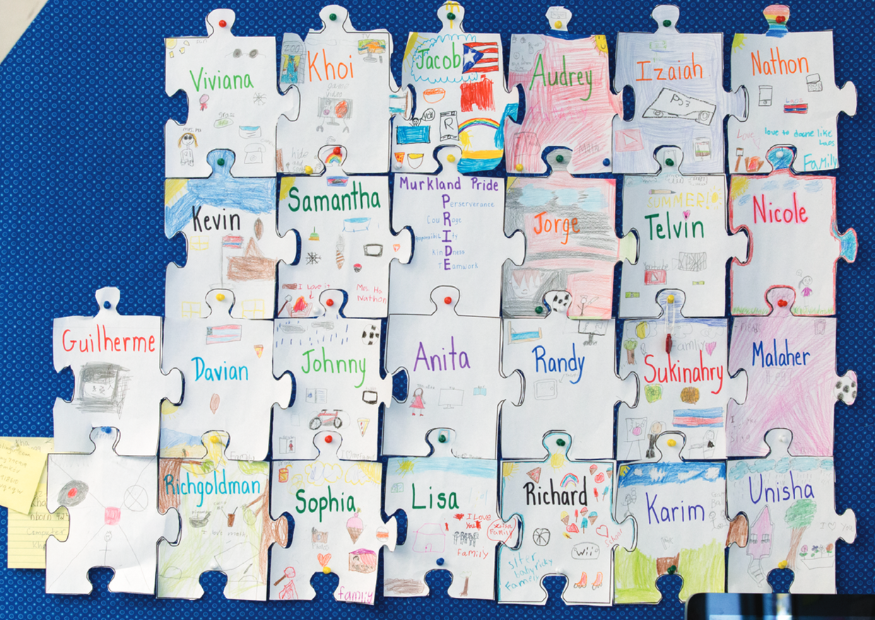
The beginning of the school year holds so much hope and promise. It’s a fresh start and another opportunity to foster a community of learners that support each other. Every single day we ask students to take risks, to be vulnerable, to reveal what they understand and what they don’t. Teaching and learning depend upon the willingness of individuals to share themselves and their ideas with their community, and so does connection, collaboration, inquiry, and joy. That willingness requires belonging.
Literacy learning is a social and constructive process. Each student’s success rests on their sense of belonging to a healthy classroom community. The health of the classroom community relies upon a predictable, safe, inclusive climate that fosters cooperation, acceptance, kindness, and responsibility. Establishing shared expectations, routines, and guidelines for working together goes a long way in making every single student feel that they are an integral part of a team with important common goals.
The beginning of the school year holds so much hope and promise. It’s a fresh start and another opportunity to foster a community of learners that support each other. Every single day we ask students to take risks, to be vulnerable, to reveal what they understand and what they don’t. Teaching and learning depend upon the willingness of individuals to share themselves and their ideas with their community, and so does connection, collaboration, inquiry, and joy. That willingness requires belonging.
Literacy learning is a social and constructive process. Each student’s success rests on their sense of belonging to a healthy classroom community. The health of the classroom community relies upon a predictable, safe, inclusive climate that fosters cooperation, acceptance, kindness, and responsibility. Establishing shared expectations, routines, and guidelines for working together goes a long way in making every single student feel that they are an integral part of a team with important common goals.
Foster a community of belonging by establishing shared expectations.
Communities thrive when members know what is expected of them and what they can expect from others. If students have input in establishing predictable work schedules, guidelines for working together, and classroom routines they develop a sense of ownership. They clearly understand their role in keeping everything moving in the right direction. They are more likely to hold themselves and their peers accountable to shared expectations. A community of belonging values sharing rationale and building consensus and commitment rather than demanding compliance and exercising authority.
Consider This:
- Knowing that the benefits to the community are worth the investment, how will you make time to have conversations about schedules, classroom guidelines, and routines that include sharing rationale and considering student input?
- Your classroom needs to establish some overall norms for working together. Which parts of the day require more specific guidelines, like transitions between whole-class, small group, and independent work time?
- There is no routine or procedure too small to teach and to practice. Before students arrive, which routines and procedures will need to be in place for your learning community to work well together? List the steps in each procedure and some teaching language that will be useful.

Foster a community of belonging by committing to inclusivity and equity.
In a community of belonging, all students feel invited and welcome to participate, and everyone gets the support they need to do so. It’s clear that every voice matters and that every individual deserves kindness and respect. Students need opportunities to make choices about their learning. Students deserve equal treatment and access to learning opportunities. Some students may need greater support than others. Children understand that inclusiveness is not negotiable, and it is their job to use their voices when they feel that anyone is being left out or left behind. Inclusivity and equity are everyone’s responsibility.
Consider This:
- Students must feel welcomed, feel safe in expressing their needs, and know their voices are valued. How will you communicate this to students immediately and in an ongoing way? What opportunities for choice can you build into learning opportunities each day?
- A community of belonging uses positive, inclusive language and behavior. How will you teach the social conventions for talking with each other, for building understanding, and for solving problems. For example:
- “I disagree with what you said because . . .”
- “Can you say more about that, because I understand it differently?”
- “I understand what you are saying, but what about _____?”
- “Can you help me understand why you think that?”
- How can I create a more accessible and welcoming environment for all community members?

Foster a community of belonging by reflecting together.
There is no single set of guidelines that will create a classroom utopia and sustain it through the school year without effort. A community of belonging is one that sets aside time to check in on its own health in an ongoing manner. The group needs many opportunities to step back and evaluate what aspects of the community are going well and which aspects need attention. Individuals need opportunities to think about how they are holding up their end of the commitments they have made to themselves and to others. Working together as a community of learners is a responsibility that requires constant reflection and adjustment. Students need regular opportunities to reflect on:
-
how their actions impact the wellbeing of the community,
-
their participation in conversations or tasks,
-
their problem-solving skills,
-
the ways in which they are providing feedback to their peers,
-
the language and tone of their interactions,
-
the ways in which they support their peers,
-
the health and safety of other members of the community,
-
the quality of their work,
-
their own time management and care for materials,
-
and on their attitudes about taking on challenges.
Discussing the health of the community is an opportunity for continuous growth. Reflection helps students understand the importance of pausing to notice triumphs and areas for improvement. . They learn that their actions impact their own learning and the collective success of the community.
Consider This:
- Reflection might happen spontaneously but be sure to make time for what you value. How can you build reflection into your daily routine? Weekly routine? Monthly routine?
- While much of the feedback you collect might come from conversation, what are some other ways that you can collect and share out feedback with the community?
- As the facilitator of this community of learners, it’s important that you engage in self-reflection. How will you hold yourself accountable to engage this community of learners in a way that fosters high expectations, inclusivity, equity, and continuous growth throughout the year? How can you collaborate with colleagues to support this work school-wide?
• • •
Want to learn more and be part of the conversation? Join the Fountas & Pinnell Literacy™ Educator Community on Facebook where Fountas & Pinnell Literacy™ (FPL) educators can collaborate, learn, reflect, and discuss pedagogy and classroom implementation alongside peers and FPL consultants.
This blog is #2 in the 3-part Create a Healthy Classroom series and was adapted from Leading for Literacy: What Every School Leader Needs to Know by Irene Fountas and Gay Su Pinnell. Click the links below to read the other blogs in the series:
1. Create a Healthy Classroom Community: The Physical Setting
2. Create a Healthy Classroom Community: A Climate of Belonging
3. Create a Healthy Classroom Community: The Home-School Connection

Leading for Literacy provides guidance for creating a culture of collaborative professionalism, facilitating conversations about effective practice, and making high-impact decisions based on evidence and the values identified by the school team. An important resource for every school leader aiming to scale up excellence, Leading for Literacy helps leaders create effective systems for improving the literacy outcomes of all students.


